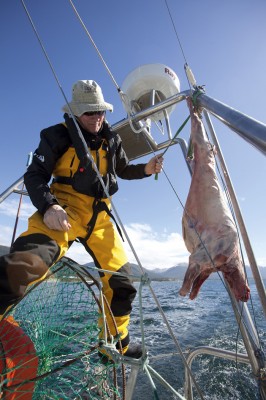Wild pioneering outpost
When Skip Novak first came here 20 years ago he described a wild pioneering outpost where self-sufficiency was conditional for survival. Now 200 cruise liners a year are turned round, there’s a busy airport and the high street is full of North Face, Berghaus and Patagonia. There’s an Irish pub, Burger King, casinos and girlie bars.
It reminded me of a scruffy version of Queenstown in South Island New Zealand where adrenalin junkies hang out, but in Ushuaia there was something more hard-edged, the snow-covered 4,500ft high Martial mountains towering to the north and the windswept, white-flecked Beagle Channel tempting us to venture east and south.
The temperature refused to budge above 8°C and when 40 knots barrelled down the Beagle Channel it didn’t feel at all like summer. Brutal is the only way to describe the weather down here, but wind was the commodity we were looking for and we were not to be disappointed.
Stepping onto Pelagic’s decks, you wouldn’t look out of place in a pair of steel-capped bovver boots because the non-slip is industrial, providing the ultimate test for our Helly Hansen foulies let alone our delicate yachting boots. Gigantic Muckmaster commercial grade wellies seemed to be the footwear of choice on deck, below and ashore. There was no way we were going to slip off this yacht!
In Pelagic’s well-insulated accommodation there was an immediate feeling of cosiness, and skipper Dave Roberts and mate Bertie Whitley, both 26-year-olds from the UK, made us feel very much at home.
Pelagic is part of a community of yachts based in this area, almost all bearing the distinctive design features necessary for survival in the deep south. Most have retro-fitted hard-topped pilothouses, four 150m mooring warps stowed on individual deck-mounted drums (one warp for each quarter) while two substantial hard-floored zodiac-style tenders are essential (ours were Bombard C3s) along with two outboards.
A stout garden hoe for clearing giant kelp off ground tackle (suitably enormous) is de rigueur and is stowed on the aft pulpit. And that’s just the kit you can see on deck – there’s more below.
And Dolly came too
‘Dolly’ is another feature you’ll see on aft pulpits here. With such a low ambient air temperature a whole lamb carcass can be lashed to the rigging and devoured over a fortnight’s expedition. Delicious until the local bird of prey the Chimango caracara plucks up courage to tuck in.
Cosy though Pelagic is, with a lovely varnished hardwood saloon table, bookshelves, diesel heater, sheepskin throws and cushions, other mod cons are out. There is no watermaker, guests are encouraged to hand pump fresh water to conserve the 500lt and showers can only be expected twice a week. Sleeping accommodation is open plan and leecloths and bunk boards are substantial.
The galley is tight, but seamanlike, helping with food preparation and washing up is expected of everyone and woe betide anyone who doesn’t pump the single Lavac head 25 times before and after use!
But abiding by these rules quickly galvanised crew and guests into a team and for those of us of a certain age memories of a cruising culture from another era soon returned. It became a very satisfactory regime.
Although there’s no separate generator aboard Pelagic there’s an enormous 500ah battery bank, providing 24V plus inverters for 12V, 220V and 110V usage, so no problems charging camera equipment. Once east and south of Puerto Williams, however, there was little or no phone or tablet connection just satellite comms in case of emergencies.
We were held up for a day in Ushuaia because with 35 knots on the clock it was simply too windy to move, so the authorities closed the port. A vast cruise liner had to lie at anchor within half a mile of her berth for a night before being allowed in and the 180ft sloop Erica XII was also confined to her dock, heeling wildly, before refuelling and heading south for Antarctica.
We received what the pilot refers to as ‘the full zarpe treatment’ – zarpe means departure form – before we left, which involved a pre-booked stamping session of passports and filling in of paperwork to enable us to leave Argentine waters. We eventually got away smoothly and headed for Puerto Williams, a small cummunity of 2,000 mainly naval personnel lying 25 miles east on the north shore of Isla Navarino.
There’s still a heavy military influence in the way Chile does business and there are strict checking in times, to say nothing of a requirement to report in by radio while cruising locally. It sounds over the top, but the Chilean authorities – ie the navy – are genuinely keen to help yachtsmen and are concerned for their safety when the wind can rise from barely nothing to an unforecast 40 knots in ten minutes.
But it wasn’t until we got to into the Woolaston group of islands south of Isla Navarino and the notorious and relatively shallow Bahia Nassau – which to the amazement of Pelagic’s regular crew we crossed in a flat calm twice – that we felt the full force of the weather we’d been looking for.







